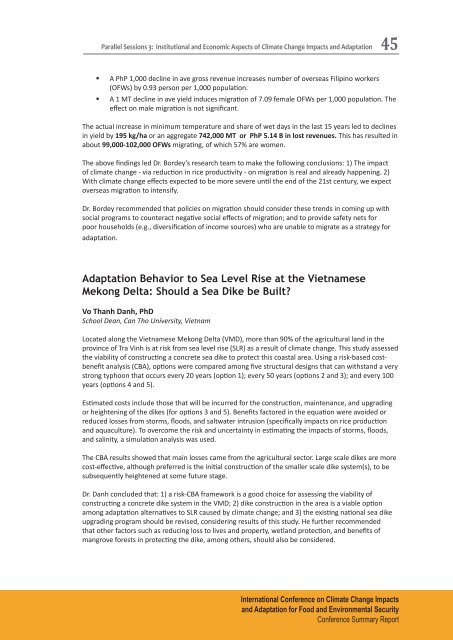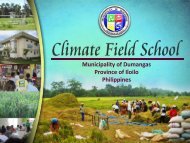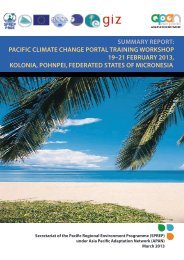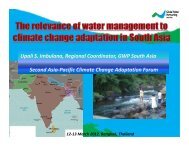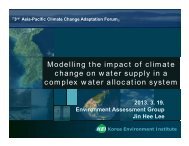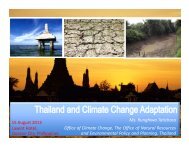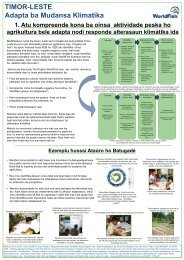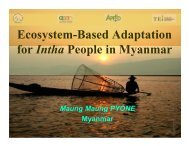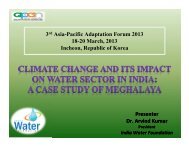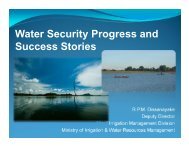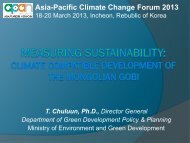PDF file (2.44 MB) - Asia Pacific Adaptation Network
PDF file (2.44 MB) - Asia Pacific Adaptation Network
PDF file (2.44 MB) - Asia Pacific Adaptation Network
Create successful ePaper yourself
Turn your PDF publications into a flip-book with our unique Google optimized e-Paper software.
Parallel Sessions 3: Institutional and Economic Aspects of Climate Change Impacts and <strong>Adaptation</strong>45• A PhP 1,000 decline in ave gross revenue increases number of overseas Filipino workers(OFWs) by 0.93 person per 1,000 population.• A 1 MT decline in ave yield induces migration of 7.09 female OFWs per 1,000 population. Theeffect on male migration is not significant.The actual increase in minimum temperature and share of wet days in the last 15 years led to declinesin yield by 195 kg/ha or an aggregate 742,000 MT or PhP 5.14 B in lost revenues. This has resulted inabout 99,000-102,000 OFWs migrating, of which 57% are women.The above findings led Dr. Bordey’s research team to make the following conclusions: 1) The impactof climate change - via reduction in rice productivity - on migration is real and already happening. 2)With climate change effects expected to be more severe until the end of the 21st century, we expectoverseas migration to intensify.Dr. Bordey recommended that policies on migration should consider these trends in coming up withsocial programs to counteract negative social effects of migration; and to provide safety nets forpoor households (e.g., diversification of income sources) who are unable to migrate as a strategy foradaptation.<strong>Adaptation</strong> Behavior to Sea Level Rise at the VietnameseMekong Delta: Should a Sea Dike be Built?Vo Thanh Danh, PhDSchool Dean, Can Tho University, VietnamLocated along the Vietnamese Mekong Delta (VMD), more than 90% of the agricultural land in theprovince of Tra Vinh is at risk from sea level rise (SLR) as a result of climate change. This study assessedthe viability of constructing a concrete sea dike to protect this coastal area. Using a risk-based costbenefitanalysis (CBA), options were compared among five structural designs that can withstand a verystrong typhoon that occurs every 20 years (option 1); every 50 years (options 2 and 3); and every 100years (options 4 and 5).Estimated costs include those that will be incurred for the construction, maintenance, and upgradingor heightening of the dikes (for options 3 and 5). Benefits factored in the equation were avoided orreduced losses from storms, floods, and saltwater intrusion (specifically impacts on rice productionand aquaculture). To overcome the risk and uncertainty in estimating the impacts of storms, floods,and salinity, a simulation analysis was used.The CBA results showed that main losses came from the agricultural sector. Large scale dikes are morecost-effective, although preferred is the initial construction of the smaller scale dike system(s), to besubsequently heightened at some future stage.Dr. Danh concluded that: 1) a risk-CBA framework is a good choice for assessing the viability ofconstructing a concrete dike system in the VMD; 2) dike construction in the area is a viable optionamong adaptation alternatives to SLR caused by climate change; and 3) the existing national sea dikeupgrading program should be revised, considering results of this study. He further recommendedthat other factors such as reducing loss to lives and property, wetland protection, and benefits ofmangrove forests in protecting the dike, among others, should also be considered.International Conference on Climate Change Impactsand <strong>Adaptation</strong> for Food and Environmental SecurityConference Summary Report


